-
TrackoBit
Manage commercial vehicles with the new-age Fleet Management Software
TrackoBit -
TrackoField
Streamline your scattered workforce with Field Force Management Software
TrackoField -
Features Resources
-
Blog
Carefully curated articles to update you on industrial trends. -
White Paper
Insightful papers and analysis on essential subject matters. -
Glossary
Explore an alphabetical list of relevant industry terms. -
What’s New
Get TrackoBit & TrackoField monthly updates here. -
Case Study
Explore the cases we solved with our diverse solutions. -
Comparisons
Compare platforms, features, and pricing to find your best fit.
-
About Us
Get to know TrackoBit: our team, ethos, values, and vision. -
Careers
Join the most dynamic cult of coders, creatives and changemakers. -
Tech Support
Learn about our technical support team and services in detail. -
Events
Check out the exhibitions where we left our marks and conquered. -
Contact Us
Connect with us and let us know how we can be of service.
What is an End-User License Agreement (EULA)?
- Author:Tithi Agarwal
- Read Time:8 min
- Published:
- Last Update: January 7, 2026
Table of Contents
Toggle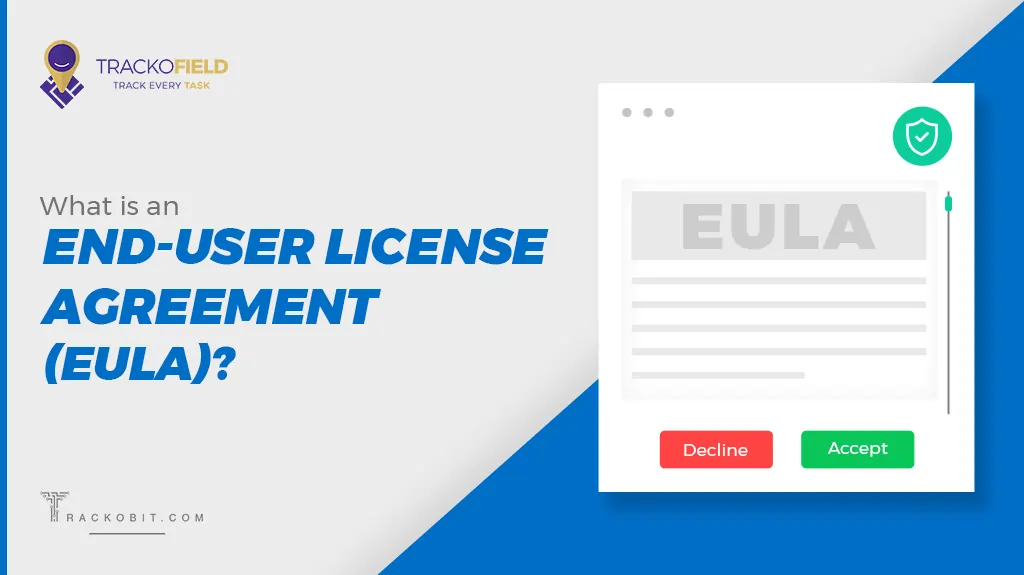
EULA, or End-user license agreement, we all know, is a legal agreement granting users a software license and how it protects ownership rights. Let’s learn the ins and outs of the EULA agreement & how it’s different from SLAs.
Table of Contents
Toggle
End-user License Agreements (EULAs) are among the digital world’s most frequently accepted yet least-read contracts. These agreements define the terms and conditions for users to access and use software. Yet, despite their importance, many users skim through or accept them without a thorough understanding.
Understanding EULAs is essential for both consumers and software providers. For users, it’s about knowing their rights and obligations when using software. For developers, it’s about safeguarding their intellectual property and minimizing legal risks. They’re usually given to users during the software set-up or installation stage and must be signed before completing installation.
In this blog, we have discussed what an EULA is, what it entails, and the difference between an EULA and an SLA.
Let’s get into it!
What is an EULA?
An EULA is a law-binding part of a terms and conditions agreement granting end-users the right to use software or applications they have bought from a vendor. An EULA establishes the following:
- How the user can use the software
- Restrictions on using the software (i.e., most EULAs prohibit users from distributing or sharing the software in any way that benefits themselves rather than the vendor)
However, EULAs are much narrower in scope than most Terms and Conditions agreements. They only cover issues related to the software’s licensing—including the right to use the software—while a Terms and Conditions agreement outlines a broad range of topics, including third-party service providers, use of the associated website, and fees and costs. A Terms and Conditions agreement for software licensing may also include an EULA.
You will be required to furnish EULAs whenever you make your software available for public use. This is because they will help in protecting the rights of the business owner or licensor. They’re also critical for managing end-users expectations and establishing how they can or can’t use the software.
As such, every business that gives customers software licenses must have EULAs. The software can include white-label fleet management software, gaming or mobile applications, or any on-premise or SaaS-based enterprise platform.
You should also draft EULAs if your company:
- Provides on-premise software or software as a service that can cause potential harm if misused
- Is legally required to make disclosures about consumer rights, particularly cancellation and withdrawal rights
- Wants to have legally enforceable control over how your product should be used
- Offers a product that has different user levels (i.e., non-registered versus registered users)
- Allows users to trade or sell with other users (i.e., an eCommerce store)
- An EULA can clarify the terms and conditions under which affiliates operate
What are the Benefits of EULA?
An End-User License Agreement (EULA) provides multiple benefits to both software providers and users. For providers, it offers legal protection by outlining the terms and conditions under which the software can be used, safeguarding intellectual property rights, and reducing liability risks by clarifying responsibilities in case of misuse or software malfunctions. For users, a EULA ensures transparency about their rights, limitations, and obligations, promoting trust and informed usage.
It often includes details about data privacy, usage restrictions, and updates, helping users understand the software’s scope and limitations. Furthermore, a well-drafted EULA can help avoid disputes by clearly setting expectations for both parties, making it a critical document in the digital economy. By providing a clear framework for the use and distribution of software, EULAs ultimately protect both the creator’s interests and the user’s rights, fostering a fair and secure software environment.
| Some Other Names for EULA
The end-user license agreement goes by a number of different names, which includes:
|
How to Create an EULA?
Here’s what you need to include when creating an EULA:
-
Defining of Parties
Describe your company and yourself. Make sure end users are aware of the complete legal name of your business before they sign any contracts. Additionally, you must state that this is an EULA agreement contract between you and the end user.
-
Grant of license
State that you are granting a license to the end-user to use the application. This is the most important part of an EULA, so be as clear as possible when writing this.
-
Limitations on use
The next step is to establish what end-users can and can’t do with your software.
Most EULAs only permit end-users to use the software for personal purposes. However, some EULAs—such as those for design and illustration software—permit end-users to use the application for commercial purposes.
For instance, a vendor of white label vehicle management software will use this agreement to invite resellers, integrators, or channel partners who can further sell their product under their ownership and brand requisites.
Either way, most or all EULAs prohibit users from doing the following without your company’s prior written consent:
- Copying the software to develop, sell, manufacture, or design third-party devices or software
- Using the software to facilitate illegal activity, such as hacking
- Leasing the app to a third-party
- Translating the app and rebranding the translated app as a new product
- Reverse engineering
- Decompiling a part or all of the software
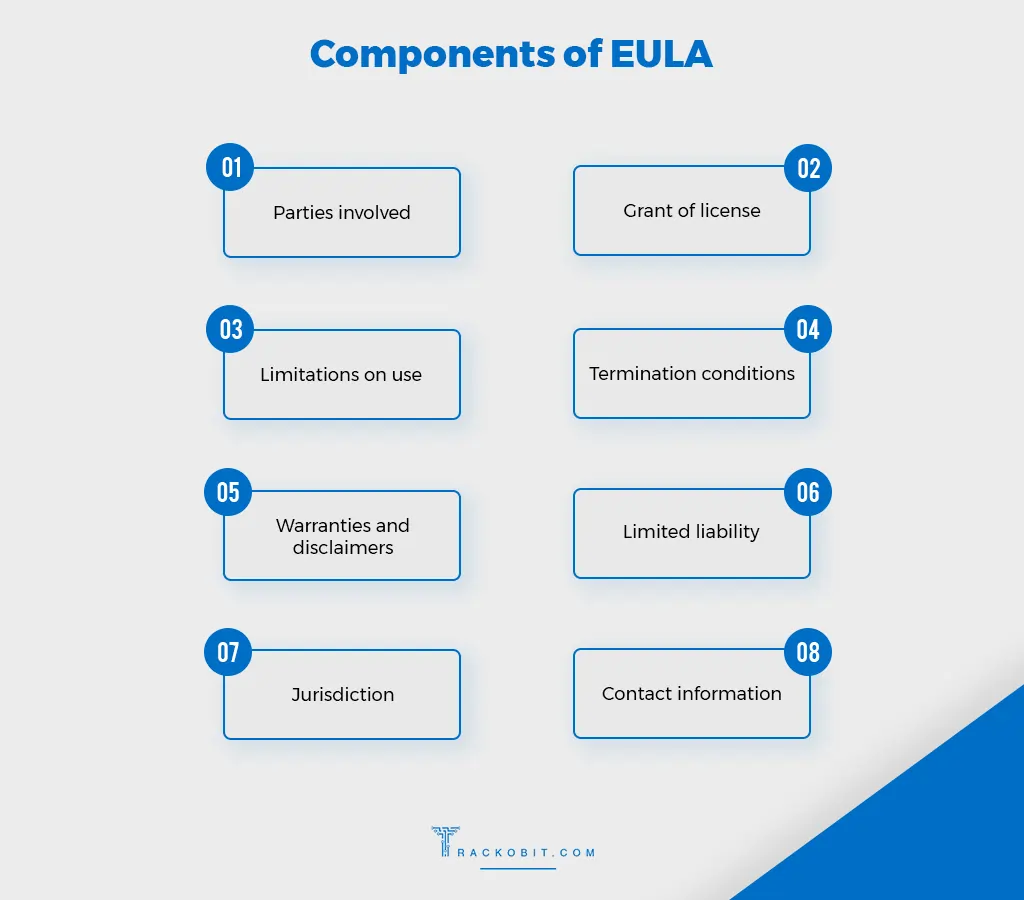
What all is included in EULA
-
Termination conditions
The end-user needs to know that you can terminate the agreement at any time if they breach the EULA, the license expires, or legal requirements aren’t met. They also need to know exactly when and under what conditions how the signed parties can withdraw from the agreement at any time.
-
Warranties and disclaimers
Since you can’t promise that your application will always run smoothly, you need to cover your bases with warranties and disclaimers.
Like white-label telematics software companies, they are required to base their warranties on performance standards, uptime guarantees, liability limits, misuse exclusions, and unauthorized modifications.
Essentially, this clause exists to remind end-users to take the product “as is” and control their expectations. Be firm about making false promises to the end-user about the application other than how it meets basic legal standards.
-
Limitation of liability
This clause will limit your liability if an end-user’s property or reputation gets damaged as a result of using your application.
You should state that you won’t be responsible for special, incidental, or consequential damages resulting from the use or malfunction of the application, which can include:
- Loss of business goodwill and reputation
- Personal injury (up to a certain extent)
- Hardware malfunction
- Property damage
- Punitive damages arising from any causes of action related to this EULA, whether from tort, strict liability, contract, or otherwise
-
Jurisdiction
State what country or state laws govern the EULA. Most businesses will choose the laws of the country or state where they have their main business, but sometimes, they may also include other jurisdictions.
For example, TrackoBit’s’ EULA lists India as their jurisdiction. However, end-users who are residents of other countries or states can choose to file proceedings in their home countries.
-
Contact information
Finally, you need to tell users who they can contact regarding their queries, questions or concerns associated with EULA. You only need to include one contact method, such as an email or phone number, but you can include more as needed.
Why Use an End-User License Agreement?
The top reasons to use an EULA are legal protection against piracy, limitation of liability, protection of intellectual property rights, and control over how the technology is used. EULAs emerged as a widespread phenomenon with the advent of personal computers in the 1980s and 90s.
-
Legal protection against piracy
First, the scope of software easily getting copied and distributed is very much possible. Although technology companies have developed sophisticated anti-piracy methods, there remains a legitimate concern that users may use the software in ways that go against the developer’s interests.
-
Limitation of Liability
Second, the software is complex and highly interdependent with other systems. Disclaimer of warranty and limitation of liability is therefore critically important in protecting software publishers from responsibility for conditions that may be outside of their control.
-
Protection of Intellectual Property rights
EULAs protect software developers’ intellectual property rights and ensure that the software is used in a manner consistent with the developer’s intentions.
-
Control over how the technology is used
In the case of content-oriented applications such as mobile video-sharing platforms or social media, software developers also wish to maintain some control over how their technology is used. EULAs provide a means of restricting activity and content that could otherwise paint the software developer negatively.
Difference Between EULA and SLA
Here’s the difference between an EULA and an SLA in terms of meaning, scope, liability, and other factors.
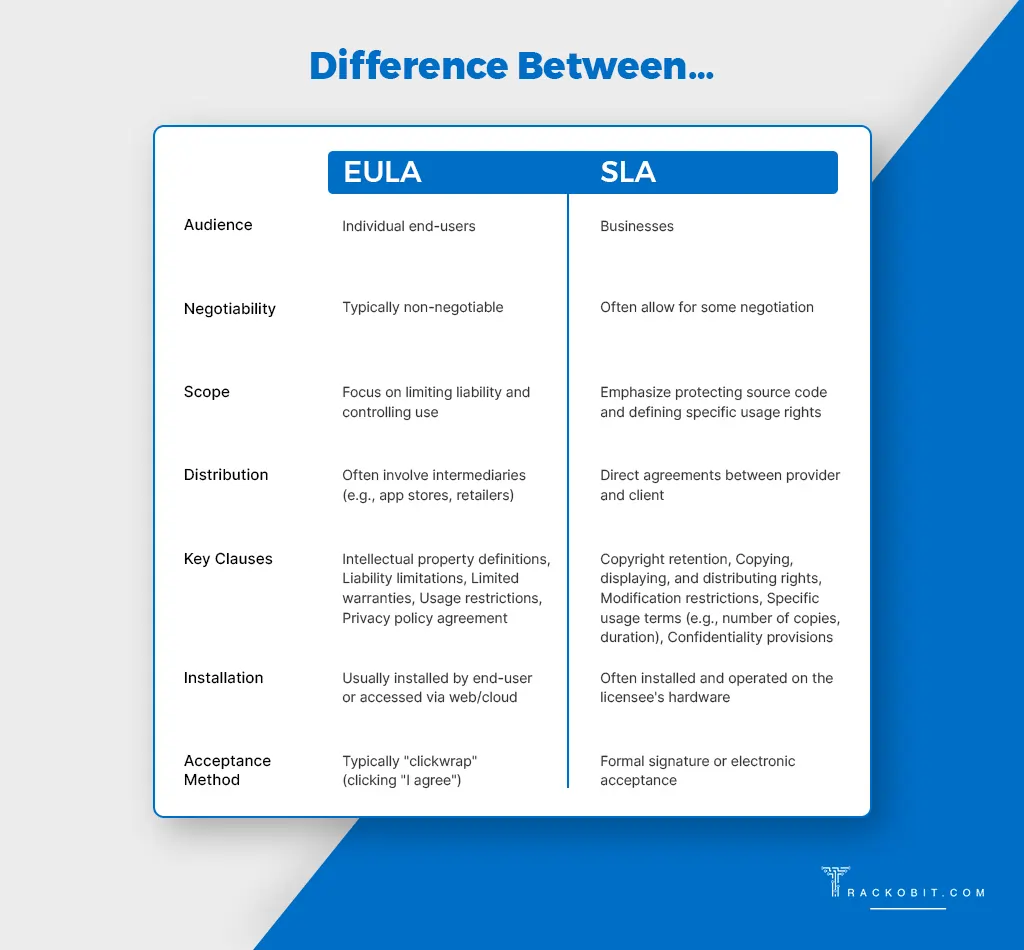
How is EULA different from SLA
Conclusion
Understanding an End-User License Agreement (EULA) is crucial for both software providers and users in today’s digital world. EULAs set the boundaries for software usage, protect intellectual property, and limit legal liabilities, offering a vital safeguard for software developers. At the same time, they ensure transparency and clarify user rights and responsibilities, fostering a fair and secure environment for all parties involved.
Growing businesses must grapple with a myriad of different agreements and contracts. As a result, EULAs have a unique place in that domain. Software developers must understand the key elements of an EULA, craft suitable end-user license agreements for their organization, and keep track of the people and organizations with whom such agreements are in effect.
More Trending Reads:
- Difference Between Dispatch and Shipment
- Top Difference Between Sales Bonus, Commission, and Incentives
- 7 Must Have Apps for Truckers in 2026
FAQs on EULA
-
What is EULA?
A legal contract known as an End-User License Agreement (EULA) is made between the person or organization purchasing software and the software provider. It describes the conditions that must be met in order to utilize the software.
-
How enforecable are EULA?
Germany does not have the same laws as the United States regarding enforcing an EULA that is displayed to the customer following a purchase. EULAs may only be enforced under European Union law if they do not go against what a reasonable customer would expect.
-
Can you refuse EULA?
Your computer may be in danger of security breaches if you ignore EULAs. You may jeopardize your privacy by ignoring EULAs. For example, in exchange for using the program, an EULA may require you to grant permission to the software publisher or a third party to collect data about your online activities.
Tithi Agarwal is an established content marketing specialist with years of experience in Telematics and the SaaS domain. With a strong background in literature and industrial expertise in technical wr... Read More
Related Blogs
-
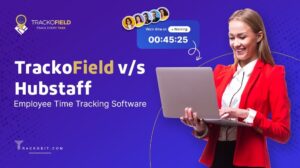
TrackoField v/s Hubstaff – Which One to Choose?
Nandita Gupta April 23, 2024Here we have shared a comparison between TrackoField v/s Hubstaff’s time tracking software. Find which one is the best pick…
-
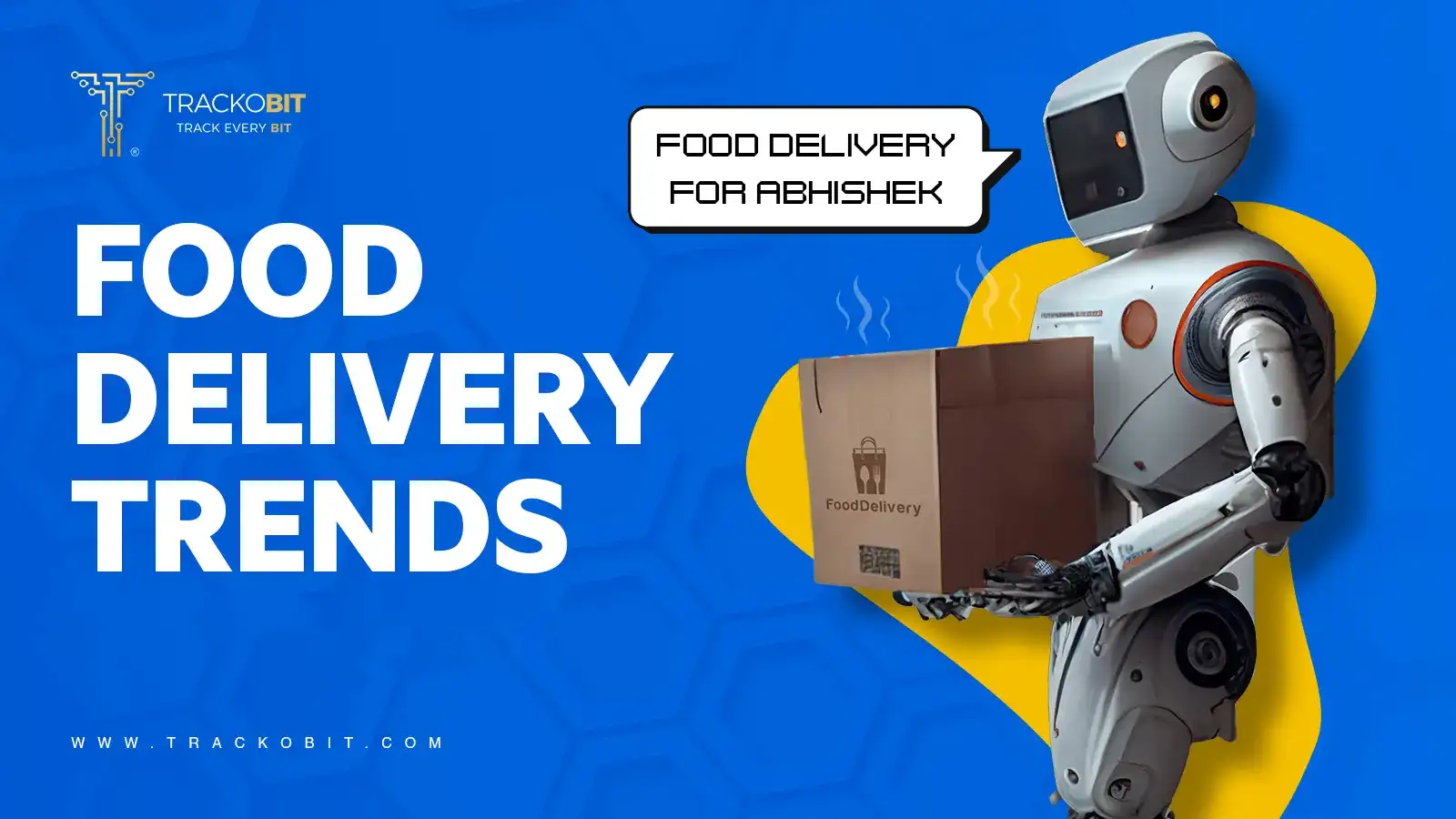
Food Delivery Trends to Watch in 2026 & Beyond
Tithi Agarwal September 18, 2023Food and technology are both revolving along with consumer demands. Here are some of the food delivery trends to watch…
-
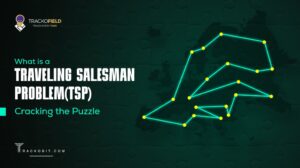
What is a Travelling Salesman Problem (TSP)? Explained!
Diksha Bhandari September 14, 2023Want to know what a travelling salesman problem (TSP) is? Need solutions to real-life TSP challenges. Learn here.
-

Biofuel – An Alternative to Fossil Fuels in Transportation | G20
Nandita Gupta September 13, 2023Transportation industries are moving towards a greener future through the sustainable use of biofuels like Ethanol — discussed in the…

Your inbox awaits a welcome email. Stay tuned for the latest blog updates & expert insights.
"While you're here, dive into some more reads or grab quick bites from our social platforms!"Stay Updated on tech, telematics and mobility. Don't miss out on the latest in the industry.
We use cookies to enhance and personalize your browsing experience. By continuing to use our website, you agree to our Privacy Policy.

































